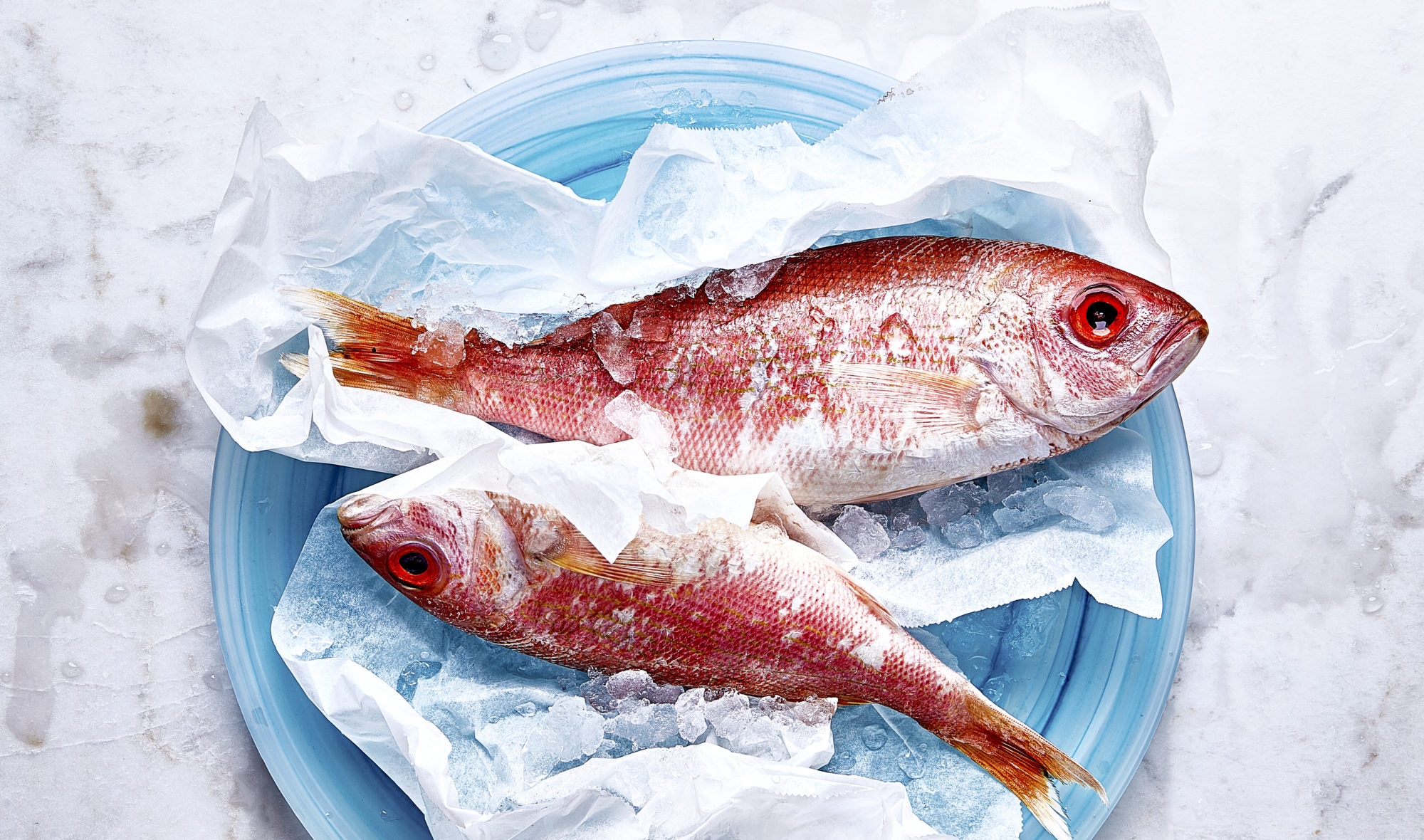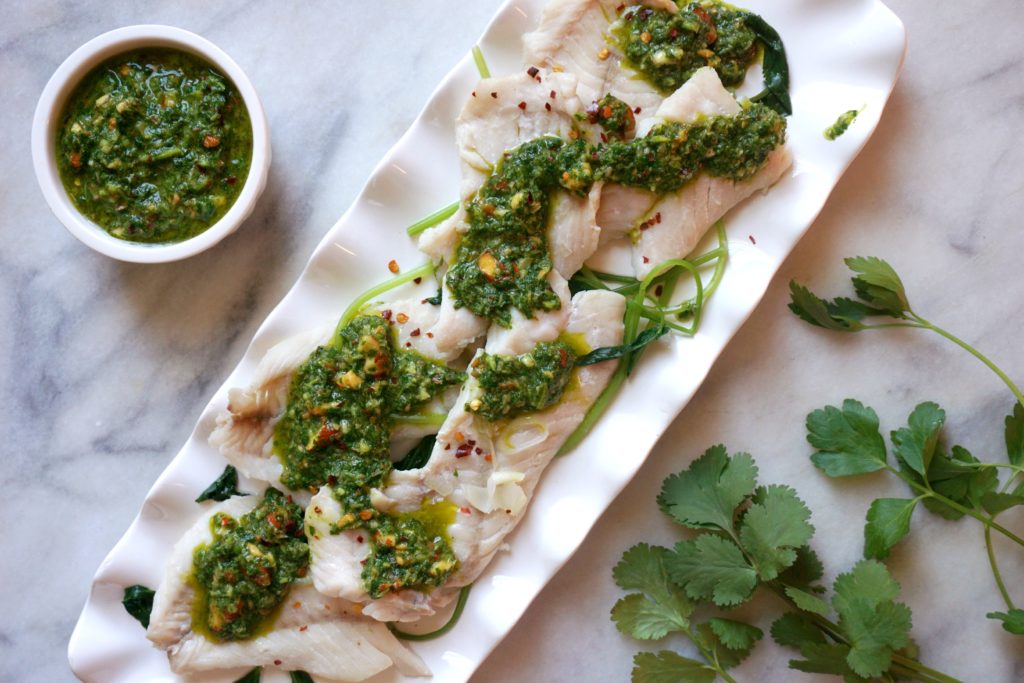
Join PN Level 2 for less than $9 USD/day! Affordable monthly payments now open.

Snapper, with its confident metallic pink hue, mohawk-like dorsal fin, and rows of sharpened needle teeth, gives off an intimidating impression. And indeed, this carnivorous fish is a top predator in the Gulf of Mexico, where it feasts on small fish and crustaceans. Luckily, humans are even higher on the food chain so we can enjoy snapper as part of a delicious meal. Its white flesh is firm, moist, and slightly sweet tasting, and it is an excellent source of lean protein as well as vitamin B12. In the 1980’s snapper stocks neared depletion, but thanks to better management of the fishing industry, snapper is making a comeback. Prepared in the right way, with a bit of butter and lemon, and you’ll be happy to have snapper keep coming back too.
The snapper is not a fish you’d want to meet in a dark ocean alley. With its confident metallic pink hue, mohawk-like dorsal fin, and rows of sharpened needle teeth, it gives off an intimidating impression. You may, like most, prefer to meet snapper on a plate dressed with some lemon and fresh herbs.
There are many different types of fish in the snapper family, but the one commonly referred to as “snapper” in the Americas is the red snapper (Lutjanus campechanus). The red snapper is native to the western Atlantic Ocean, including the Gulf of Mexico. They are a top predator in the Gulf ecosystem (remember those pointy teeth?) and feast on small fish and crustaceans.
In the 1980’s snapper stocks neared depletion, but thanks to better management of the fishing industry, snapper is making a comeback.
Snapper is a medium to large fish that can range between two to three feet in length. It has flashy pink scales and a prominent dorsal fin with a laterally compressed body.
Snapper is a meaty fish, with a good yield of lean white flesh with a moist, yet firm texture. Like most white fish, its flavor is mild and slightly sweet.
Three ounces of cooked snapper (about 85g) has 109 calories, 22.4g protein, 1.5g of fat, and no carbohydrates, fiber, or sugar. Snapper is an excellent source of vitamin B12.
As with most seafood purchases, when selecting snapper, shop at quality stores you trust. A good fish monger should be able to tell you about the fish you are purchasing: what species it is, when and where it was fished, and how to store and prepare it.
Snapper may be found whole or in fillets, fresh or frozen.
Fresh fillets will have a rosy tinge, and should look moist, but not wet, with little separation between the muscle fibers. For fillets, choose skin-on, as skin-off fillets might not be genuine red snapper. The skin of a red snapper should have a distinctive rosy hue.
When purchasing a whole fish, look for tightly-adhering, shiny scales, deep red fins, pinkish-silver bellies, clean red gills, and clear, glassy eyes.
Fresh snapper should be displayed over ice. If you are able to, give the fish a sniff. Fresh snapper should have a pleasant oceanic smell.
Trust your nose. If it smells “off”, look elsewhere.
The length of time fresh snapper can be stored depends on when the fish was caught, but generally, if well-wrapped in plastic and preferably stored over ice, it can be kept in the fridge for about five days after it is caught. If you don’t know when it was caught, eat it within a day or two.
Snapper can also be frozen. Wrap it well to prevent freezer burn, and store for about about two months.
Once it’s cooked, snapper can be kept in an airtight container in the fridge for five to six days, or in the freezer for two to three months.
Snapper can be baked, sautéed, grilled, or stewed. One of the simplest and fastest methods is to sauté it.
Here’s how to do it:
Ideally, pick fillets that still have the skin on one side. The characteristic pink metallic skin is one way to to tell that you have purchased true red snapper and not some other imposter fish, but also, the skin becomes delicious and crispy when fried.
First, pat the fillets dry with paper towel, and season both sides with salt and pepper. Over medium high heat, heat olive oil or butter in a non-stick frying pan until a flick of water sizzles upon contact with the pan’s surface.
Place the fillets in the pan, skin side down, and cook for 3 to 4 minutes, or until the skin is golden brown. Flip the fillets, and then cook for an additional 3 minutes or so. The snapper is done when it has lost its translucency and flakes easily when poked with a fork.
Season the fillet with a squeeze of fresh lemon, some fresh chopped parsley or cilantro, and a bit of additional butter, olive oil, or seasoning if needed, and then serve.

Snapper is a tender and delicate-tasting white fish. Fresh and herbaceous chimichurri is the perfect compliment to it, as it adds delicious flavour without overpowering it.
Prep Time: 15 minutes Cook Time: 10 minutes Yield: 8-10 servings chimichurri and 4 servings snapper
For the Roasted Almond Chimichurri
Place all ingredients into a food processor and pulse until desired texture is achieved.
Reserve leftovers in a sealed container in the fridge for up to 5 days. Delicious served over fish, chicken, cooked vegetables, or pasta.
For the Poached Snapper
In a deep skillet, add several inches of water, herbs, shallot, and salt, and bring to a simmer. Carefully place fillets in the skillet, and continue simmering until fish turns opaque, but still tender, about 10 minutes.
Remove fillets from water with a slotted spoon or spatula, and lay out on a plate. Drizzle generously with chimichurri, season with extra salt and pepper if desired, and serve.
Precision Nutrition’s Encyclopedia of Food expands every single month as we highlight new foods and showcase beautiful food photography. If you’d like to stay up to date, simply click this link. From there, we’ll send you a FREE copy of our recipe book. We’ll also let you know when new and delicious foods are added to the site.
Snapper, with its confident metallic pink hue, mohawk-like dorsal fin, and rows of sharpened needle teeth, gives off an intimidating impression. And indeed, this carnivorous fish is a top predator in the Gulf of Mexico, where it feasts on small fish and crustaceans. Luckily, humans are even higher on the food chain so we can enjoy snapper as part of a delicious meal. Its white flesh is firm, moist, and slightly sweet tasting, and it is an excellent source of lean protein as well as vitamin B12. In the 1980’s snapper stocks neared depletion, but thanks to better management of the fishing industry, snapper is making a comeback. Prepared in the right way, with a bit of butter and lemon, and you’ll be happy to have snapper keep coming back too.